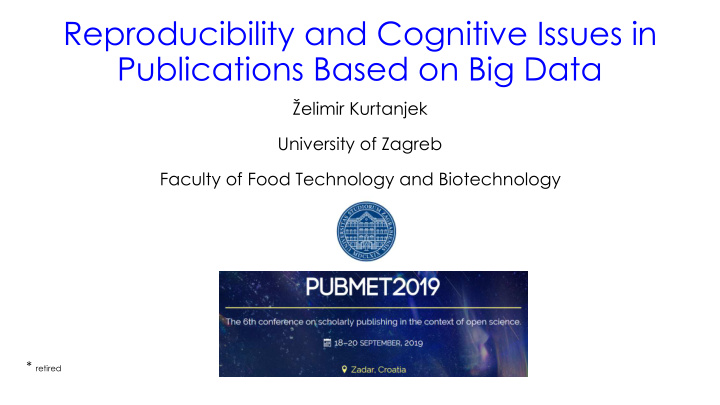



Reproducibility and Cognitive Issues in Publications Based on Big Data Ž elimir Kurtanjek University of Zagreb Faculty of Food Technology and Biotechnology * retired
Outline ➢ Big Data critical issues ➢ Life sciences, technical sciences, social sciences, ➢ Prominent examples ➢ Sources of contradictions ➢ Data forensics ➢ Causality, model validation and p-value inference ➢ Propositions of editorial corrective measures ➢ Conclusions
How big are „Big Data” and its two faces ➢ Data size (EU human genome project) ➢ 3 x10^9 (base pairs) x 10^7 human x 10^3 phenotypes = 10^19 numerical data ➢ „Gold bars” and „new oil” versus „card castles”
Big Data are omnipresent ➢ Life sciences: Mendelian large cohort studies, genetics, proteomics, glycomics, metabolomics, nutrigenomics.. ➢ Technical sciences: AI, G5, Internet of Things, Robotics ➢ Social sciences: behavioral studies, social networks, .. ➢ Economy: Financial engineering, marketing, managment ➢ Government: e-government policies, cyber security ..
Big data with „two faces” ➢ Big data have high market value and are power engine („new oil”) of G5 economy ➢ Big data research produces „houses of cards”, i.e. look plausible (nice) but do not „touch”
What are problems with Big Data research publications ? Top 10 most high impact retracted papers are in field of Life Science
Examples ?????
Causality structure of Big Data research Causal Y=f(X) relation W Randomized Y=f(X, W ≈ 0) trials Adjusted confounders, Y=f(X, W ) Propensity X Y score Y=f(X, W) Confounded causality W confiders of high dimension, some unobserved X causality X={0,1} Y effect Y ={0,1}, Y= {R} Causality analysis is study of effect of counterfactuals
Main problems with Big Data published research are due to: ➢ Lack of causality model (structure) ➢ Missing methodology for confounder adjustments ➢ Unvalidated data (experimental procedures) ➢ Unvalidated model predictions ➢ Unreported confidence bounds for inference parameters (p-values) The problems are of systemic, „deep” nature and require main changes in journal editorial policies
Software tools available to editorial boards (reviewers) for „check” of Big Data manuscripts ➢ Data forensics (Benford „law”) ➢ Stat-checking software
GWAS association
Basic methodologies for Big Data validation (that should be imposed by editorial policies) Data set folding Model validation by Data set bootstrapping Inference validation by
Data forensics What is Benford’s Law and why is it important for data science? Benford’s law tells us about expected distribution of significant digits in a diverse set of naturally occurring datasets and how this can be used for anomaly or fraud detection in scientific or technical publications !!!! The first record on data sets from 1881 Mathematical proof published in 1996 in paper: A Statistical Derivation of the Significant-Digit Law Theodore P. Hill School of Mathematics and Center for Applied Probability Georgia Institute of Technology Atlanta, GA
Yeast GW expression (mRNA) data Data source: M. Brauer at al. http://growthrate.princeton.edu/ "https://4va.github.io/biodatasci/data/brauer2007_tidy.csv "
Yeast GW gene (mRNA) expressions under substrate limitations Data forensics by Benford’s „law” Benford law does not validate for N=2 , hence mRNA expression data error level is ~10 %
Conclusions ➢ Advances of high throughput experimental techniques and information technologies led to Big Data science a dominant trend in life sciences, also in other scientific fields (social, economy, production technologies, …) ➢ Due to new technologies, complexity and size of Big Data research for science publishers have resulted in pressure to change and adjust editorial policies to meet challenges of data validation and cognitive contribution of published manuscripts. ➢ High impact factor of retracted (erroneous cognition) Big Data longitudinal research in human health fields makes them seriously damaging. ➢ The „old policy” that a single reviewer is competent for a whole content of a submitted manuscript is mostly untrue. A group of experts in different aspects of Big Data projects should cooperate and produce a single integrated review („triangulation by reviewers”). ➢ Policies of Open science data, publication and reviews is essential for research in life sciences. ➢ To editorial boards are available methodologies and software supports for validation of model predictions and cognitive inferences in Big Data research. ➢ Most of issues won’t be solved with a single rule or policy, the best solution available is to just start discussing ways how we can improve practice of Big Data and related analytical fields.
Recommend
More recommend